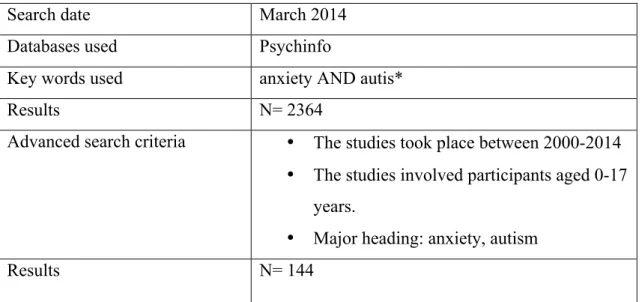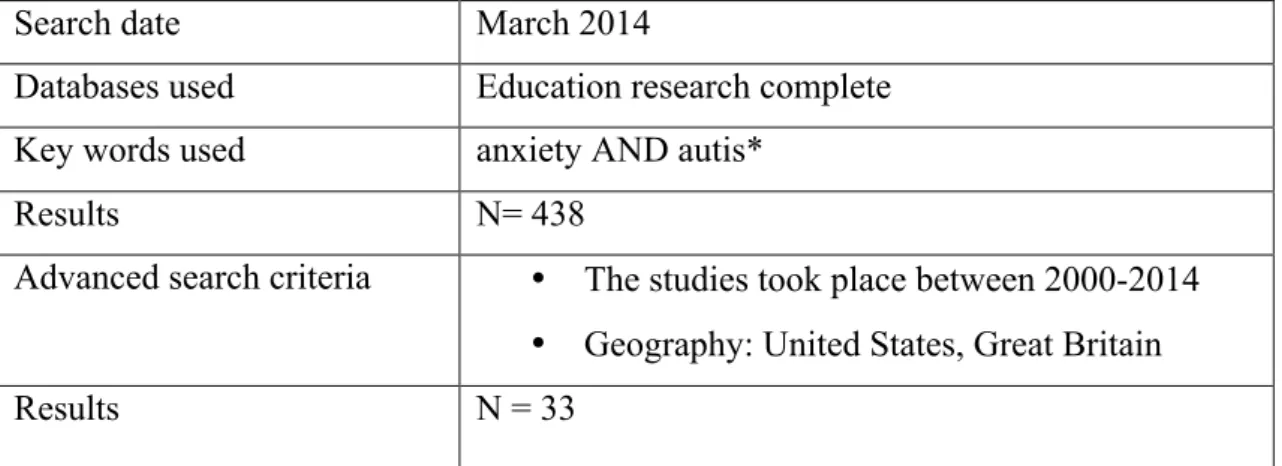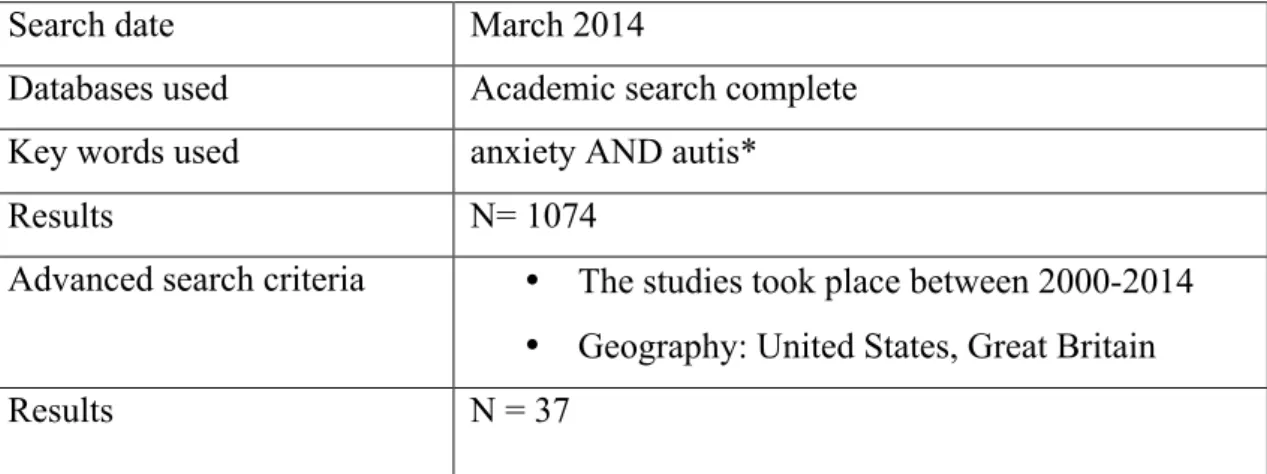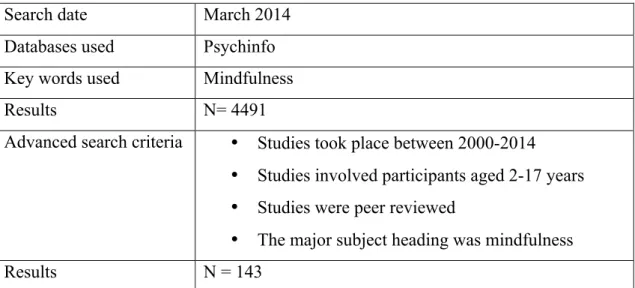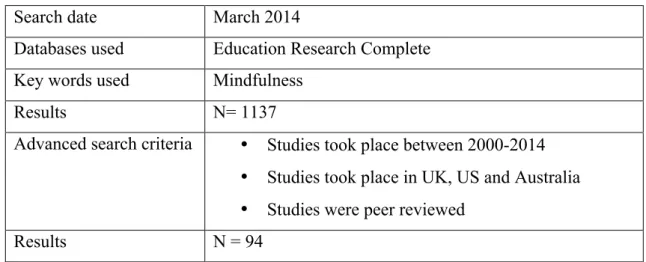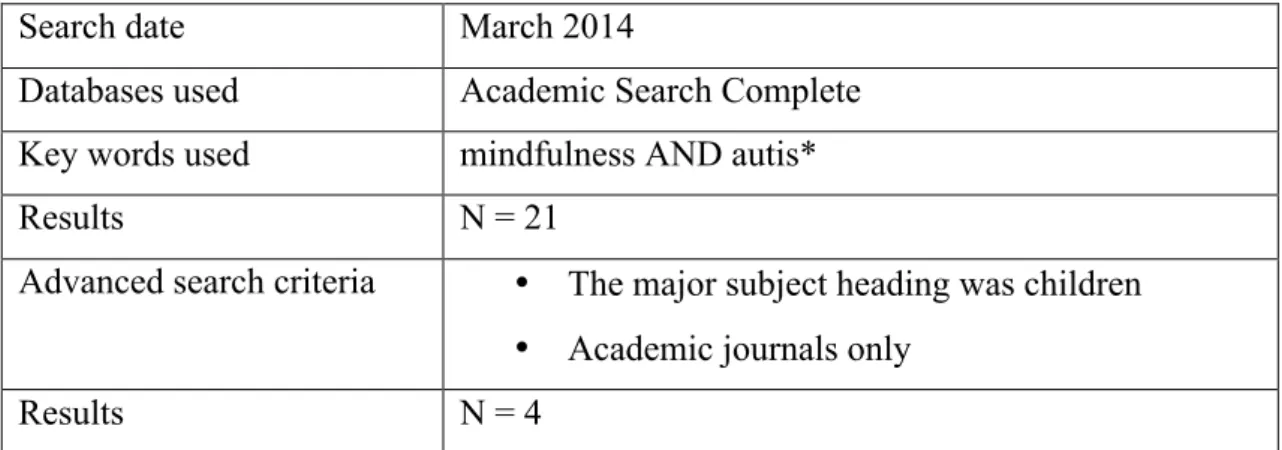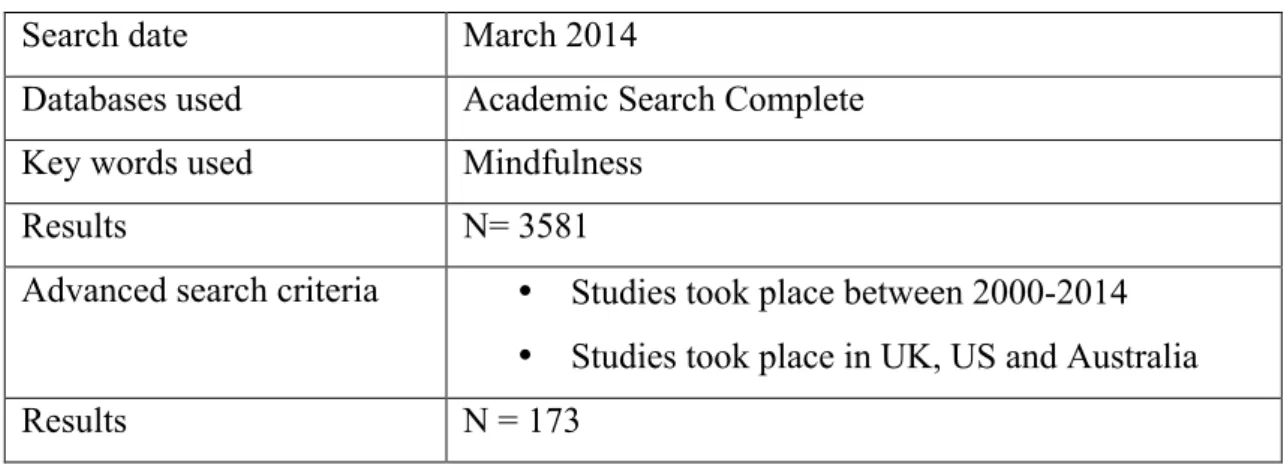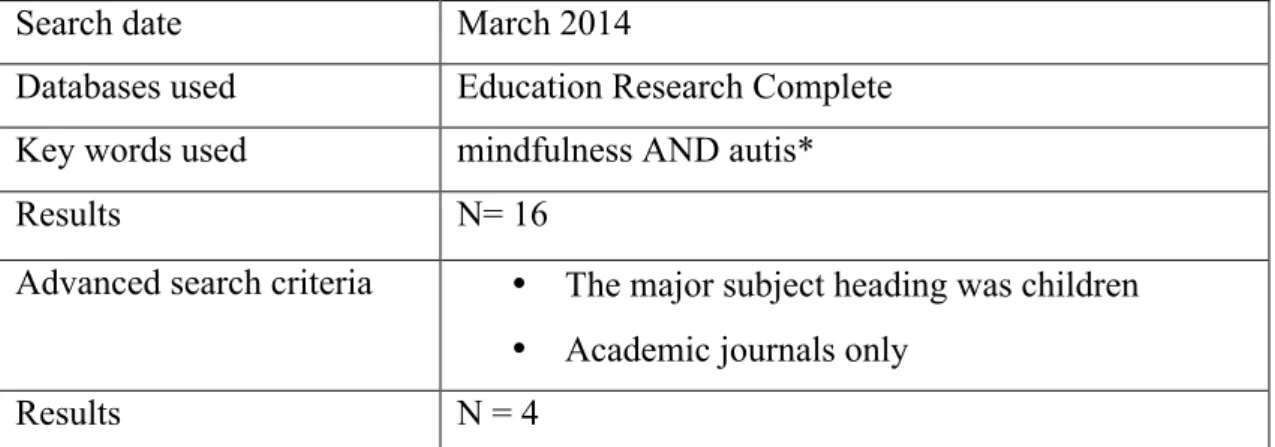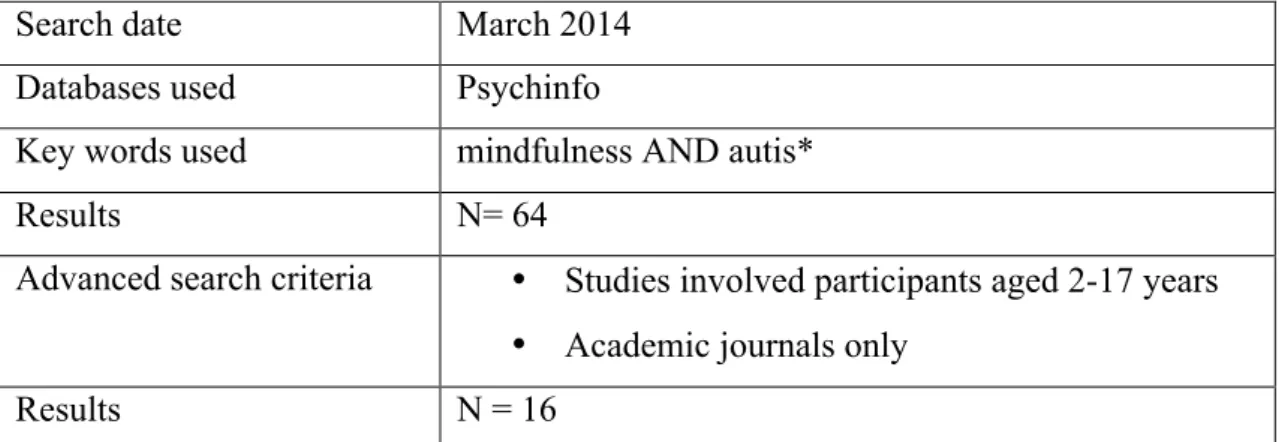The central research question was, what do children with ADHD say about their experiences of being part of a mindfulness program? Special thanks go to the principal educational psychologist and my mentor, who greatly supported and facilitated the development of this research.
Introduction
Chapter Overview
National Context and Background Concerning Mental Health
The Mental Health Coalition was launched in the House of Lords in March 2010 and its campaigns have included prioritizing early intervention and teaching emotional resilience. The third category of "social, emotional and mental health difficulties" is the new terminology for school staff, as it was previously called "Social, emotional and behavioral difficulties".
National Context and Background Concerning Autism
It is clear that if schools are required to better address mental health and psychological well-being in schools, there is an imperative to provide support to enable this, and although recent legislation appears to recognize this (Carter, 2015; DoH, 2015; DfE, 2015) , it is not yet clear how the Government will deliver this training and support. These gaps are particularly evident in relation to children with disabilities and SEN, preventive work and targeted support for well-being and mental health education; it seems that the duty for all these tasks can be transferred to educators.
National Context Concerning Listening to Children
Additionally, this research should be embedded in an ethos of collaboration with autistic individuals to ensure their voices are heard. This way of working is consistent with the wishes of many autistic individuals (Pellicano et al., 2013).
Local Context and Background
In response to the proposed changes proposed in the DfE Green Paper (DfE, 2011), which outlined the vision for a new system for PIP, the LA established support and effort working groups. Therefore, research into psychological well-being was deemed necessary by LA, and PEP agreed and enabled the research to progress in this direction.
The Theoretical Basis of Mindfulness
Although mindfulness has its origins in Eastern religious and philosophical ideologies, modern mindfulness is a secular practice. Finally, mindfulness is often understood to have the same meaning as the skill of focusing attention.
Position and Interest of the Researcher
Summary and Research Rationale
Chapter Overview
Literature Review Strategy
A systematic research review of the available published literature was then conducted using a series of search terms in several electronic databases. Two-stage screening: papers identified where there is no immediate screening Electronic search term: mindfulness Academic research complete (ARC) N=3060 Education Research Complete (ERC) N= 950 Psychinfo N=4921 Total N= 8931 Electronic search term: mindfulness and autis * ARC N= 21 ERC N= 16 Psychinfo N= 64 Total N= 101 One stage screening: papers identified in ways that allow immediate screening, e.g.
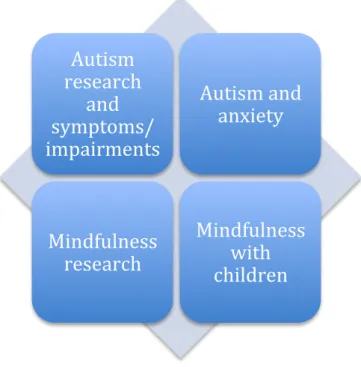
The Presenting Needs of Children with Autistic Spectrum Disorder
After identifying the most relevant results using the systematic keyword search, abstracts were read and then selected or discarded. The researcher also read references from the most relevant articles to ensure that a thorough and comprehensive literature search was conducted.
Autism Research
Autism can be caused by non-genetic factors, but it is likely that such cases constitute only a minority of cases (Levy, Mandell & Schultz, 2009 cited in Pellicano et al., 2013). The bulk of UK published research on autism between 2001 and 2011 focused on biology, neuroanatomy and cognition (Pellicano et al., 2013).
Research Evidence for Anxiety Difficulties in Children with ASD
However, using both parent and child reports, Russell and Sofronoff (2005) found that children with Asperger. Despite the correlational findings of the relationship between ASD and anxiety, it is unclear why children with ASD appear to have.
The Relationship Between ASD Difficulties And Anxiety
- Attention
- Executive functioning
- Central coherence
Frith's cognitive theory of 'central coherence' has sought to address both deficits and assets in ASD. Central coherence is a well-established theory that is generally well supported by research findings (Best, Moffat, Powers, Owens & Johnstone, 2007) although some findings have found only partial support for the theory, in terms of being able to initiate organized scheme of events. Loth, Gomez & Happe ́, 2008).
Current Uses of Mindfulness
ASD, the literature review will now focus on the current uses of mindfulness-based therapies and the evidence base for their effectiveness in reducing anxiety and improving well-being.
Mindfulness Research with Adults
Limitations of this study include the sample of undergraduate student participants, which limits the generalizability of the findings; and the closed-ended self-report questionnaire method, which limits the richness of the data. Hill and Updegraff (2012) conducted a self-report study with 96 undergraduate students and found that mindfulness was associated with greater emotional differentiation and fewer emotional problems based on the Five Facets of Mindfulness Questionnaire (Baer, Smith, Hopkins, Krietemeyer & Toney, 2006 ). and the Emotion Regulation Difficulties Scale (Gratz & Roemer, 2004).
Mindfulness Research with Young People
Huppert and Johnson (2010) examined the effects of mindfulness training on general adolescent well-being with a modified MBSR program. This study provided some rich data on how mindfulness applies to an adolescent and the methodology fits the subjectivity of mindfulness as a tradition.
Mindfulness Research with Children
- Mindfulness and anxiety, depression and behavioural difficulties
- Minority groups
- Increased attention
- Executive functioning and cognitive flexibility
- Emotional regulation and social skills
Measures included The Child Behavior Checklist: Teacher Report Form (Achenbach, 1991), The Multidimensional Anxiety Scale for Children (March, 1997), and The State Trait Anxiety Inventory for Children (Spielberger et al., 1973). Furthermore, qualitative research can be vulnerable to bias due to the relationship between the researcher and the participants.
Mindfulness for Adults with Autism
There was no control group in this study and the changes noted by pre- and post-measures may have been influenced by the teacher's perceptions.
Mindfulness Research with Children and Young People Who Have Autism
2011) conducted an evaluation of the effectiveness of a mindfulness intervention for anger management in adolescents with autism. The change in the mothers'. interactions with their children could also have explained the positive impact on aggression, rather than the direct impact of the intervention on the adolescents.
Current Research
- Research aims
- Research questions
At the time of writing, no further research was available on the use of mindfulness for children with autism. What children with ASD say about their experiences of being part of the awareness program.
Chapter Overview
Research Aims and Purpose
- Research aims
- Research purpose
Creswell (2009) describes different purposes of research and classifies them as exploratory, explanatory, evaluative and investigative and classifies them as exploratory, explanatory, evaluative and.
Research Paradigm
Epistemology deals with the way in which the researcher acquires knowledge of reality and has a relationship with this knowledge. Constructionists adopt an interpretivist epistemology, and consider an interactive link between the researcher and participants to allow findings that are subjective and co-created.
Research Questions
The researcher has an interest in and background in counseling and psychotherapy and believes in the existence of multiple realities, all of which are equally valid and socially constructed, so the researcher's goal was to "understand the multiple constructs of meaning and knowledge" (Mertens, 2005 , p.14). What do children with ASD say about their experiences of participating in the mindfulness project.
Research Design
- Qualitative methodology
- Rationale for the use of Interpretative Phenomenological Analysis
In this way, the research adopted an idiographic perspective and chose to study each individual's account of the phenomenon of mindfulness as a unique case rather than being interested only in the ways in which accounts differ (Ashworth, 2008). Due to the phenomenological nature of the research, Interpretive Phenomenological Analysis (IPA) was decided to be more appropriate than other qualitative methods of analysis, as it enabled an exploration of the phenomena of awareness as the participant and researcher construct them .
Participants
- Sampling method
- Inclusion criteria
- Recruitment process
The school showed interest and willingness to participate in the study, so the researcher sent a letter (Appendix 4) and a research information guide (Appendix 5) to further inform the SENCo about the study. After children gave their informed consent to the school staff member, the researcher visited the school and double-checked that the children had understood the study and consent.
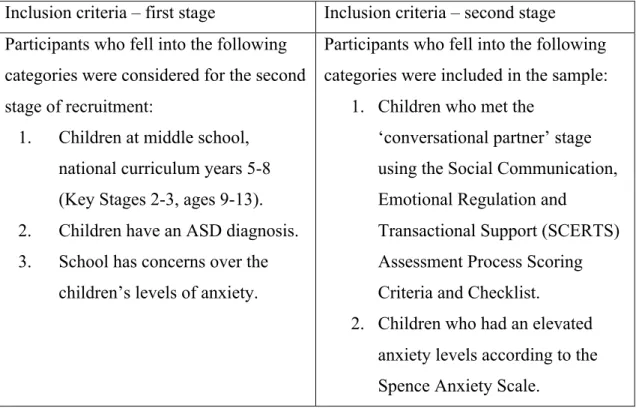
Inclusion Criteria Assessment Tools
- SCERTS assessment process scoring criteria and checklist
- Spence Children's Anxiety Scale
Nevertheless, the SCAS has been described as useful for children “who function better and have moderate language and cognitive skills” (Grondhuis & Aman, 2012, p. 1360). Due to the evidence supporting the SCAS and the fact that it was used simply as a screening tool for participant inclusion in this study, the investigator judged it to be an appropriate assessment of anxiety.
The Mindfulness Programme
- Design of the mindfulness programme
- Delivery of the mindfulness programme
This was with the intention of limiting any bias of the school staff in delivering the program. The teaching assistant engaged in her own practice during the time she taught the program using the MBCT based book and CD 'Mindfulness'.
Data Collection
- Research timeline
- Pilot session
- Interviews
- Audio diaries
The pilot study led to changes in the resources used in the program and the sequence of activities. Completion of the pilot study resulted in the researcher feeling confident and comfortable in the interview situation, which is another factor that can instill confidence in the participant.
Data Analysis
- IPA principles of analysis
- IPA process of analysis
Create tables of new themes for participant one for each data set (interview 1, audio diary, interview 2). The use of these analytical strategies created a representation of the emerging themes for each participant for each data set (interview 1, audio diary, interview 2), as can be seen in Figure 3.10.2.8.
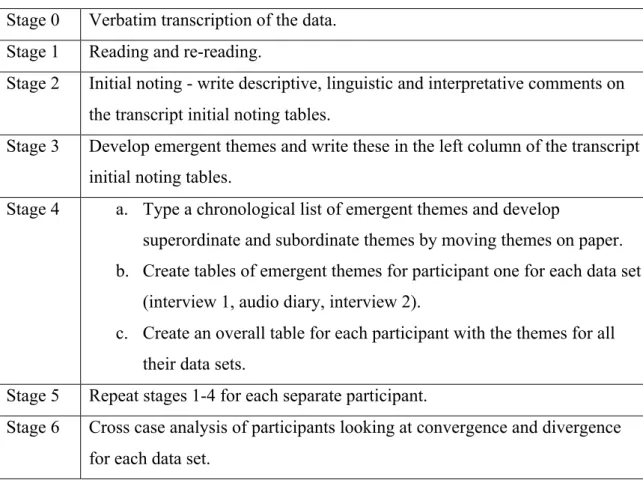
Ethical Considerations
- Protection from harm
- Consent
- Anonymity and confidentiality
The researcher gave this trial session to the children with the teaching assistant, a trusted member of staff. The children were asked to choose pseudo names to replace their real names in the research report and in the data transcripts.
Validity and trustworthiness of the research
- Validity in qualitative research
- Procedures for enhancing validity
The first element considered was the triangulation of the researcher's perspectives with those of other researchers. It was important that the researcher's interpretation of the participants' interpretations remained central to the analysis and to the other researchers.
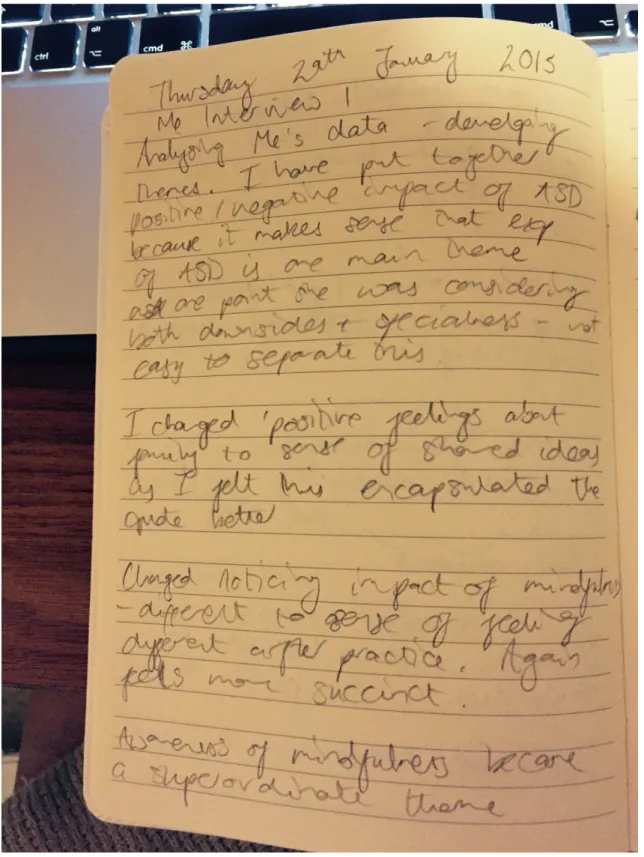
Reflexivity
Finlay (2008) states that most phenomenological researchers would agree with the process of reflexivity as "one of the more (if not the most) significant dimensions of phenomenological research" (p.4). The next chapter demonstrates how the researcher came to an understanding of the participants' experiences through analysis of the data, and how her presuppositions were bracketed throughout the analysis.
Analysis
Chapter overview
Individual analysis
Summaries are followed by a presentation of the analysis of each of the three datasets: the first interview, the audio diary and the last interview. After analyzing each dataset, the analysis will be commented as a whole for each participant and finally as a whole for the group, to present the group's shared experience.
Participant One: Me
- Me -‐ interview one
- Me -‐ audio diary
- Me -‐ interview two
- Me -‐ final themes
The superordinate and subordinate themes developed through analysis of Ms interview one are shown in Table 4.3.1. The superordinate and subordinate themes developed through analysis of Ms interview two are shown in Table 4.3.3.
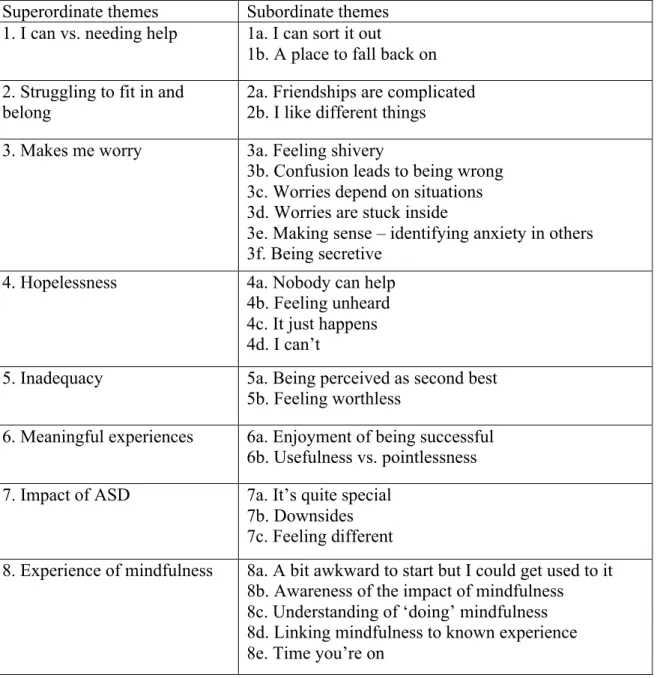
Participant Two: Jack
- Jack -‐ interview one
- Jack -‐ audio diary
- Jack-‐ interview two
- Jack -‐ final themes
The following Table 4.4.4 presents the superordinate and subordinate themes developed through analysis of Jack's data. Worries Stuck in the past 2 127 Usually from the past Fear of the future 1 149 What happened in the past.
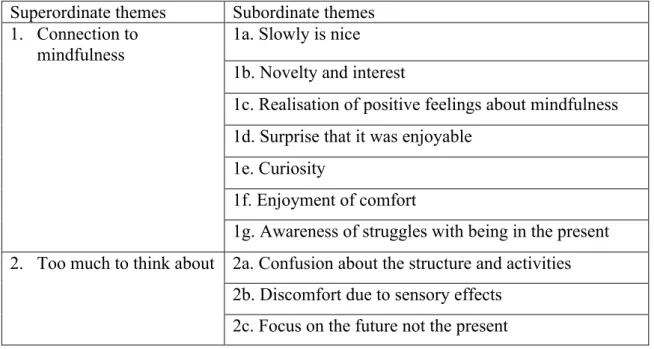
Participant Three: Jerry
- Jerry -‐ interview one
- Jerry -‐ audio diary
- Jerry -‐ interview two
- Jerry -‐ final themes
The overarching and sub-themes that were developed through analysis of Jerry's audio diary are shown in Table 4.5.2. The following Table 4.5.4 presents the overarching and sub-themes that were developed through analysis of Jerry's data.
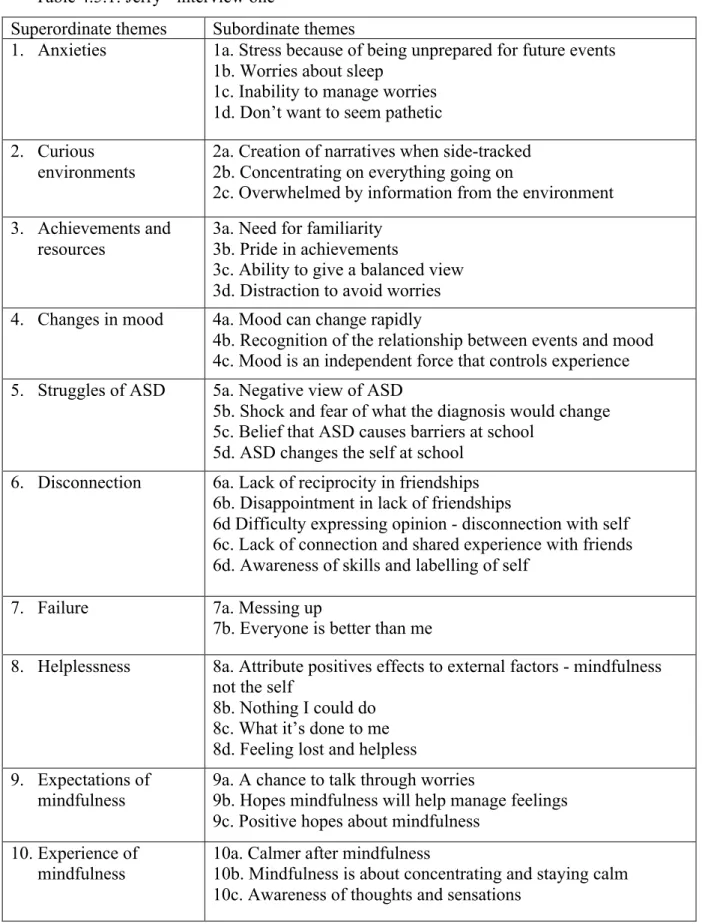
Participant Four: Amy
- Amy -‐ interview one
- Amy -‐ audio diary
- Amy-‐ interview two
- Amy -‐ final themes
The superordinate and subordinate themes developed through the analysis of Amy's audio diary are shown in Table 4.6.2. The following Table 4.6.4 presents the superordinate and subordinate themes that were developed through the analysis of Amy's data.
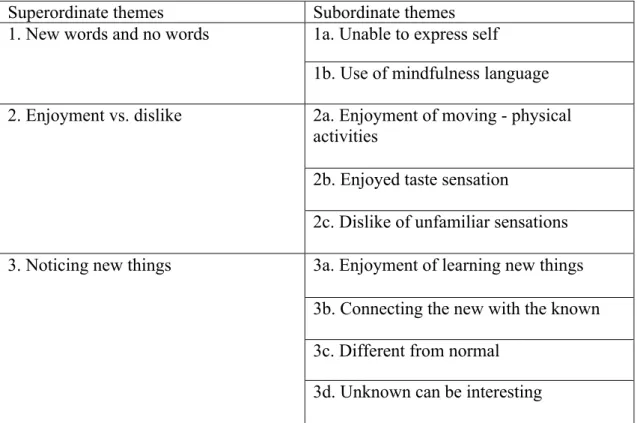
Group Analysis
- Theme one -‐ Worries
- Theme two -‐ Perceptions of self
- Theme three -‐ Relationships
- Theme four-‐ Connecting to the environment
- Theme five -‐ Views of autism
- Theme six-‐ Perception and experiences of mindfulness
So it's just your point of view..and you can't, you're not able to, erm, like, you can't, there's no right or wrong answer so you can only say what you want and you don't have to like to think in mind" (Me, second interview, line 460-463). It was interesting..because we didn't have anything from the magic box so it was interesting what we were going to do..because normally you can see what's in there..and you can look...” (Amy, audio diary, line 18- 26).
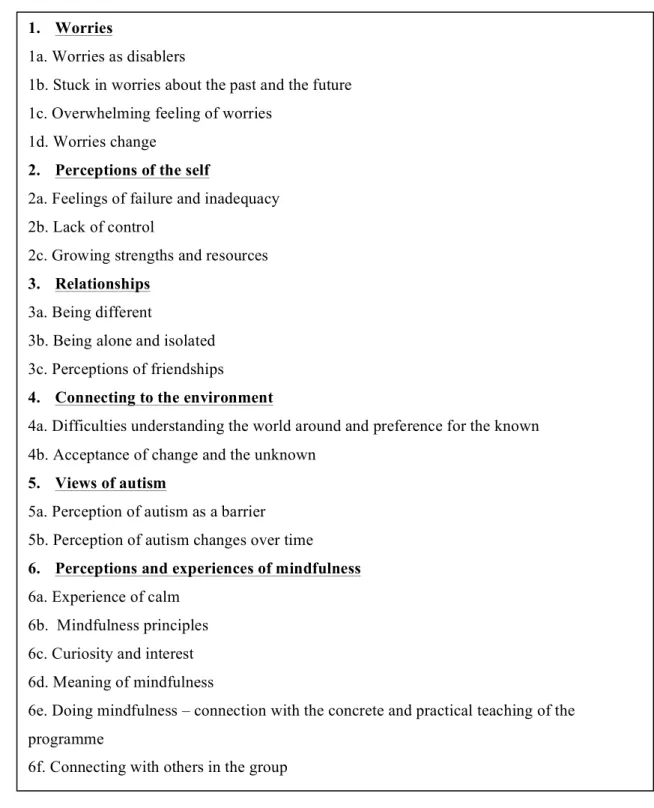
Summary of Analysis
Meg described sadness at the end of the group, which gave a sense of how meaningful it had been for her. Mindfulness was experienced as a calming factor for each child, and they explored a number of different understandings of mindfulness principles.
Chapter Overview
Commentary on Key Findings in Relation to the Research Questions
- Children’s experiences of being part of the mindfulness programme
- Children’s life experiences
- Change to children’s lived experience
The children were somewhat aware of their personal strengths, but these seemed to be overshadowed by feelings of failure. Most of the children's stories reflected their struggles with friendships and a sense of their wish for things to be different.
Commentary on Key Findings in Relation to the Literature Review
- Perceptions and experiences of mindfulness
- Relationships with others
- Worries
- Perceptions of the self
- Connecting with the environment
- Views of autism
- Relation to key theories in autism
- Summary of the research findings
A sense of belonging and togetherness began to develop as they shared similar experiences. 2008) noted that mindfulness improves mindful awareness, and other research has reported that mindfulness predicted high levels of self-esteem, low levels of social anxiety (Rasmussen & Pidgeon, 2011), and increased social skills (Beauchemin et al., 2012). Many factors may have contributed to the change in children's experience of their autism, but possibly the benefits of mindfulness in increasing awareness, emotional regulation (Singh et al., 2013) and positive emotions found by previous research (Hill & Updegraff, 2012; ( Schonert -Reichl & Lawlor, 2010) could have influenced the change in lived experience.
Convergences and Divergences
The children's accounts did not attach much importance to the concepts of mindfulness, so they seemed to experience mindfulness as a 'task-oriented' activity. The children described a shift in their ability to enjoy new things and notice and accept change.
Limitations
- IPA with children
- Researcher-‐ participant relationship
- Limitations in epistemology and methodology
At the same time, the researcher had to be aware of her own interpretations – the double hermeneutic part of the IPA process. In addition, the researcher must be clear about her role and position in the research.
Implications of the Research
In addition, this research has highlighted the benefits and accessibility of therapeutic support for children with autism. In addition to implications for the implementation of mindfulness programs for children and youth, this research was able to provide insight into some of the. Perceptions and understanding of autism from the perspective of children with autism.
Implications for Educational Psychologists
- Intervention work
- Evaluation of interventions contributing to the research base
- Collaborative and systemic working
This research has emphasized the voices of children with ASD and provides EPs with evidence of the insight children with ASD have into their own lives. This research has demonstrated the unique role of the EP in upskilling, strengthening and monitoring the practice of school staff.
Researcher’s Reflections of the Research Journey
- Overview of my reflective process
- The research process
- Personal impact of this research
- Impact on my role as trainee Educational Psychologist
- Final reflections and conclusions
I like that he always shows who he is”: the perceptions and experiences of siblings with a brother with an autism spectrum disorder. Measuring Anxiety in Children with Autism Spectrum Disorders: The Reliability and Validity of the Spence Children's Anxiety Scale.
List of Abbreviations
Summary of the results from systematic literature review
A controlled trial of mindfulness training in schools: the importance of practice for an impact on well-being. A randomized trial of mindfulness-based cognitive therapy for children: promoting mindful attention to improve social-emotional resilience in children.
Copy of ethical approval
Example of research request letter for school staff
Example of research information guide for school staff and parents
I will interview the children for about 20 minutes each time at the beginning, middle and end of the intervention. The content of the sessions will be kept confidential, unless there is a risk of someone being hurt or injured.
Example of SCERTS worksheet for assessing communication
Example of consent form for parents
Example of information sheet for pupils
Example of consent form for pupils
I understand that when the research is written into a book, Jodie will change her name so that my opinion is anonymous. I understand that Jodie will not talk to anyone about what I say unless I say something that means I or someone else could be unsafe.
Example of Spence Children’s Anxiety Scale
Spence Children’s Anxiety Scale scores
Considerations made in the design of the mindfulness programme in
Mindfulness programme overview
Example mindfulness session outline
Example mindfulness session guide
Example visual resources
Example of pilot session plan
Initial interview question table used to plan questions to meet the
Initial interview schedule used in the pilot interview
Final interview question table used to plan questions to meet the research
Final interview schedule used in the interviews
Transcript example
Initial noting example 1
Initial noting example 2
Final themes poster for Jerry
Final themes poster for Jack
Final themes poster for Amy
Final theme poster for the group
Minutes of IPA meeting
Research diary reflections
